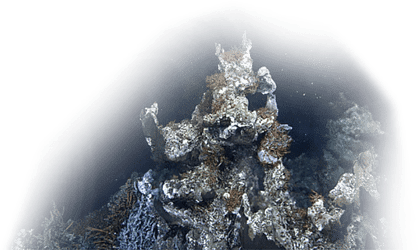Ocean Networks Canada (ONC) visiting scientist Pere Puig is a marine geologist whose expertise in deep sea sediment dynamics is contributing to our growing understanding of the importance of submarine canyons. And, as the grandson of a shrimp fisherman in northern Spain, Pere’s research is also having a direct influence on Mediterranean fishing practices.
Pere Puig, marine geologist and head of the Marine Geosciences Department at the Institute of Marine Sciences in Barcelona, with a photo of a shrimp boat from his hometown, Blanes. This boat is similar to the one his grandfather piloted in the 70’s.
Spain is known for its abundant—and delicious—seafood; in 2015, Spain was the European Union’s biggest market for seafood products, according to SeafoodSource.com. The waters north of Barcelona are one of the most productive fisheries in the Mediterranean, but periodically, adult shrimp have been known to disappear for years. The collapse of the shrimp fishery in 2005 prompted Pere and his team at the Marine Sciences Institute to conduct a study, which revealed the cause and accurately predicted the return of the shrimp in 2008.
By analyzing 30 years of data, Pere’s research revealed that particularly cold Mediterranean winters chill the ocean surface, creating a fast-moving downward cascade of dense water that carries huge amounts of sediment—and crustaceans—into the deep ocean. The data also revealed that historically, the shrimp populations recover within three to five years following these underwater ‘floods’, likely due to the additional nutrients that arrive with the sediment.
Caught red-handed: strong muddy currents can wipe out valuable populations of red shrimp (Aristeus antennatus). Photo credit: Francesc Sarda.
By solving a perennial mystery, local fishers have grown to trust Pere’s scientific insights. This research has been useful for fisheries management, especially in Palamós harbour and in Pere’s hometown, Blanes.
The Impacts of bottom trawling
In 2012, Pere authored a leading research paper in Nature, documenting the detrimental impact of bottom trawling on the ocean ecosystem. A New York Times editorial summarized the research, stating, “It is the equivalent of plowing a cornfield, with this difference: a farmer plows his own field once a year, but trawlers cover ‘the same grounds year round on a daily basis’. Marine life flourishes in complexity, which bottom trawling destroys.”
“While the fishermen already knew that trawling gear was scraping the seafloor, they were unaware of the ecological implications of constantly removing sediment from fishing grounds,” comments Pere. “Our study led them to think differently and to auto-impose a ban on the use of heavy bottom trawling gear in Palamós harbour.”
ONC is no stranger to the effects of bottom trawling: ONC’s Barkley Canyon installation was damaged by heavy duty fishing gear three times. The first occurred in February 2011, when Barkley’s upper slope platform was flipped over. It took a year to re-establish live-streaming from this important research site. In 2013, also at the upper slope, the offshore profiling system was severed from its seafloor mooring. And in January 2015, the Barkley Canyon node was damaged, halting all data delivery from this site for 18 months.
A trawl scar on the sea floor at Clayoquot Slope, 2011.
In January 2016, Pere began his three-year term as the ONC science theme leader for Seafloor and Sediment in Motion. During his five month stay as visiting scientist from May – September 2016, Pere focused on three initiatives:
Barkley Canyon
In June, as part of Wiring the Abyss Expedition 2016, Pere helped to install two autonomous moorings at the head of Barkley Canyon. Although previous studies had been conducted in the depths of the canyon using ONC’s sensors installed at a depth of 1000 m, these new instruments—deployed in approximately 400 m of water—will provide unique information to study the sedimentary processes occurring in the shallower water at the head of the canyon.
Map of Ocean Networks Canada installations at Barkley Canyon, NE Pacific Ocean
The results from these new mooring deployments will be gathered until 2017, when Pere will begin his important analysis of the data.
INCISE International Submarine Canyon Symposium
In July, ONC hosted the third INCISE International Submarine Canyon Symposium in Victoria, British Columbia to present state-of-the-art submarine canyon research and discuss new technology, marine policy, and conservation. Pere helped to organize this international gathering, and led a special session on sediment transport and a follow-up workshop dedicated to the challenges of monitoring active turbidity currents.
INCISE 2016 organizers (l-r): Fabio De Leo, Jaime Davies, Veerle Huvenne and Pere Puig.
Studying suspended particles
Pere studied 2012-2014 data from ONC’s vertical profiling system, installed at a depth of 396 m on Barkley Upper Slope. This instrument travels up and down the water column, measuring a variety of water properties including turbidity and currents. Pere looked for increases in suspended particle concentrations that could be attributed to bottom trawling activities.
After being immersed in ONC activities for five months, Pere was able to offer fresh perspective on how ONC serves its users.
“Pere has provided us with extremely valuable insights as to how researchers can and should interact with ONC’s science, data, and engineering staff to achieve their scientific goals,” says Richard Dewey, ONC’s Associate Director for Science Services.
Pere returned to the Institute of Marine Sciences in Barcelona at the end of September. He plans to spend the next three years studying the impacts of trawling in other Mediterranean regions, such as Sicily. Stay tuned for more updates!
Related Articles
INCISE 2016 gathers the international submarine canyon community
